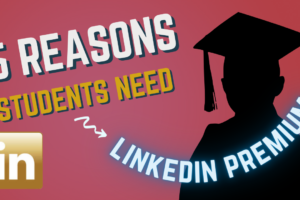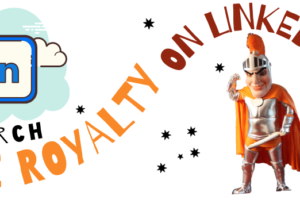When I originally set out to write this post, the title I was kicking around was College Professor: Reasons Why You Should Be ACTIVE On LinkedIn. The main idea was to impress the importance of being active. However, the current title has a higher search engine ranking score. The tactics of titling posts for search engine ranking will be a point I return to later; however, being active on LinkedIn remains the central thesis of this post. It’s not just enough to have a profile on LinkedIn; the best way to approach LinkedIn is to engage.
LinkedIn has more than 740 million users and is a growing social media powerhouse. It is not just for networking among professionals. It is now an influential content platform, powerful search engine, and marketing gold mine. In Q1 of 2021, LinkedIn’s revenue increased by 21% year-over-year and the amount of content shared on LinkedIn increased by 50%.
You’re on LinkedIn, but are you ACTIVE on LinkedIn? If you’re not engaging the platform, you’re missing opportunities. If you’re not feeding the beast (aka algorithm), you’re not being found. In this post, I hope to convince colleagues of the value — financial, social, education, professional — that LinkedIn can provide faculty who are active on the platform.
Source: 31 LinkedIn Stats That Marketers Need to Know in 2021 (hubspot.com)
Kick-Ass Search Engine
The first mistake people make with LinkedIn is thinking of it as a networking site. In practice, it’s a powerful search engine. LinkedIn profits by feeding recruiters, sales professionals, businesses, careerists, etc. expected search results.
LinkedIn’s algorithm presents results based on the expectations of the user asking for the results. If you regularly share and engage with others’ content, you will expand your network within your niche and feed content to the algorithm that signals you’re a subject matter expert. When someone is looking to hire a consultant or keynote speaker in your area of expertise, you’ll appear higher in search results.
In short, how LinkedIn knows whether you should be presented at the top of a search — as a potential candidate for a job or a consulting opportunity — is based on what you’ve told the algorithm. Keywords matter, but what you share and how you engage with content will determine what content it will send to others’ feeds. If you don’t share often, then your content will quickly fall off people’s feeds and you’ll rank lower in search results.
Just for the purposes of illustration, expand the blue accordion below to view Screenshot 1. This screenshot is the Southern Illinois University’s LinkedIn alumni page. I will point to this screenshot multiple times. For this section, I want to emphasize two things: 1. how dialed in a search can get and 2. those who rank at or near the top are likely to get the most engagement.
Freelance & Consulting Opps
I’m an associate professor of business communication. According to Indeed.com, the average salary of an associate professor in the United States is $70,215. Fortunately, I’ve got side gigs to make an annual income more commensurate with my education and skills. Over the past decade, a significant portion of my consulting income has come from the network effect of the LinkedIn platform and from LinkedIn itself because I am one of their preferred vendors. Over the past 10 years, I have earned approximately $150K from LinkedIn directly or indirectly.
One of the most valuable products that delivers a consistent flow of clients is LinkedIn ProFinder. I was invited to join the ProFinder program as a resume consultant when the product/service was still in beta because the LinkedIn algorithm identified me as an on-platform expert. My point here is that by being active on the platform, I positioned myself well for opportunities that were being invented. In 2017, 2018, and 2019, I was a top 10 ProFinder consultant. Because of my rank, I was invited by LinkedIn to be part of their MVP Career Coaching Program. I’ve worked directly with LinkedIn as a preferred vendor providing resume writing, LinkedIn reviews, and interview coaching to their clients. None of these opportunities would have materialized if I wasn’t ranked high in search and didn’t have content, such as reviews and posts, that signals to profile visitors (like LinkedIn staff and potential clients) that I am an expert in this area.
What is more, by sharing content in other areas of interests, such as talent development, instructional design, public speaking, career/executive coaching, and higher education, I have been invited to join a variety of projects. When I share content, I remind my connections that I am around and do these things. In short, my network remembers me when someone they know is seeking help in one of my areas of knowledge. Just over the past month, I have been asked to join a research project, participate in a podcast, and have earned over $3K in revenue from assisting connections or their referrals with various writing projects.
Recruitment & Retention
Recruitment and retention is becoming a metric by which faculty are measured. Sourcing, emailing, texting, and calling prospective students are now common faculty practices. I spend on average three to five hours per week doing closing activities for my department (e.g., meeting in-person with students and parents, emailing, calling, setting up student-alumni Q&As). I also engage in inbound marketing activities on LinkedIn. Let’s face it, most high school students are not using LinkedIn. My target audience are adults who interact with high school students: parents/guardians, high school counselors, employers, etc.
I regularly engage with posts that reflect a positive sentiment and experience of Southern Illinois University Carbondale. When these land in my networks’ feeds (and beyond if they also engage), it puts SIUC on the radar of adults who could eventually mention SIUC as an institution to consider. Of course, LinkedIn offers many opportunities for recruiting to faculty who work at institutions with graduate programs. Pay-per-click ads and organic posts about programs prove very effective. For example, I often recommend DePaul University’s PRAD program because I regularly see ads for DePaul (similar to one highlighted in Screenshot 2) and because I read Ron Culp’s posts (see also Screenshot 2). Ron Culp does LinkedIn right, so pay attention to his feed! Another faculty who does LinkedIn right is Dr. Keri Stephens, a professor at UT Austin.
Dr. Stephens regularly engages the platform, so her content shows up frequently in my feed. Her content illustrates how LinkedIn can help with retention, which means keeping students in one’s program once they have joined. LinkedIn can be part of retention strategy. Let me explain.
When faculty offer a shoutout to the work of current students or alumni, it signals the value of the degree. As students and parents increasingly focus on degree-to-career prospects, demonstrating the importance and value of a degree in immediate terms is key to framing the narrative of a degree’s value. Here it is important to show, not tell. A LinkedIn post highlights key features about a program to potential, current, and former students in real-time. (See Screenshot 3 for an awesome example.)
What is more, Dr. Stephens also provides a nice shoutout to students, which signals to recruiters that her students are worth note. The algorithm will elevate the tagged students in search rank for sales jobs. As they land opportunities, it reinforces the value of the degree. These students will remember this gesture for years; however, the content will likely be considered relevant to alumni and appear on their feeds. By appearing on feeds, this content will remind these alumni of their fondness for the program, motivate them to request to be a pipeline for future interns or talent, and keep Dr. Stephen’s subject-matter expertise in their minds.
Side note: Dr. Stephen’s posts have motivated me to explore starting a sales minor at SIUC, which should aid in my own recruitment and retention efforts. Again, just another LinkedIn result.
Alumni Relations
The above sections should make it clear that LinkedIn provides many ways in which alumni are directly and indirectly engaged vis-à-vis active engagement on the platform. It is an easy and convenient way to track students once they leave a program. By using the alumni search tools (Screenshot 1), departments can collect data on where students land later in their careers. Knowing this information is valuable for explaining the long-term efficacy of a degree’s value.
Other ways I use LinkedIn is to find alumni speakers for our BrandU event (a career development and recruiting event that engages current and former students through engaging workshops), internship placements, and fundraising. On this last point: I regularly interact with alumni through LinkedIn and engage their posts, so when I turn around and ask for something in return, it doesn’t seem off-putting. For this reason, I’ve been able to turn the platform into a way to do some fundraising for my department. In March 2021, during SIUC’s Day of Giving, I raised over $2K from nearly 50 donors (more than any other faculty in my College). Many of the donors were recent graduates. Without LinkedIn, this would not have been possible.
Skills Enhancement
Finally, being active on LinkedIn can lead to skills enhancement. I will be covering this idea in more detail in future posts, so follow me so you don’t miss this amazing and useful content. Here is just a short list of how LinkedIn has helped me enhance my skills. First, I’ve taken several courses on LinkedIn Learning that have improved my capabilities around disability support, accessibility and universal design, and instructional design. Second, I pay attention to what my connections and influencers say and how they say it, which has enhanced my marketing and writing skills. Third, I see industry trends and get introduced to new products that I seek to learn.
I am fortunate that what I teach is sort of what I do on LinkedIn. In my business communication course, for example, we discuss SEO and click-thru rates. It is important to craft a good headline, title, or email subject line. By engaging on LinkedIn, my ability to draft clickable titles and thumbnail pictures has improved. I’ve therefore become a better instructor in this area. I bring the data and results from posts directly into class, to prove as illustrated that there is a right way to actually approach LinkedIn: activity!
About Craig
Dr. Craig Engstrom is an associate professor of business communication at Southern Illinois University Carbondale and founder/chief consultant of Communication@Work LLC.
Get more tips via YouTube >> https://youtube.com/craigengstrom







